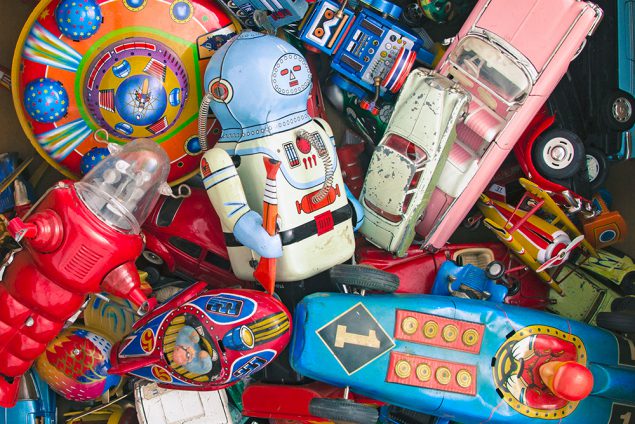Lead in Consumer Products
Lead can be found in some consumer products made in other countries and then imported into the United States. Lead can also be found in collectible items no longer produced in the U.S. but passed down through the generations.

New Fact Sheet: Recalls of Children’s Products, Foods, Cosmetics, and Medicines Due to Lead Hazards.
Some toys, especially those that are imported or are antique toys, and toy jewelry may contain lead.
- Imported Toys. Toys made in other countries are more likely to contain lead than toys made in, for example, the United States, Canada, or the European Union.1 Lead paint was banned for use in house paint, on products marketed to children, and on dishes or cookware in the United States in 1978. However, it is still widely used in many other countries.
- Antique Toys. Toys made before the ban on lead paint in 1978 may contain lead-based paint. Therefore, painted antiques or collectible toys that are passed down through generations may contain lead. Additionally, older toys made of tin, brass, or pewter alloys may contain lead.
- Jewelry. Lead is often used in jewelry, including children’s jewelry, to make the product heavier, brighten colors, and stabilize or soften plastic.2,3,4 Jewelry labeled as made in the United States is less likely to contain lead compared with jewelry made abroad and purchased through informal and unregulated sources. Children should not be allowed to wear jewelry that may contain lead because of exposure from chewing, sucking on, or swallowing jewelry.
- Plastic Toys and Other Products. The use of lead in plastics has not been banned. Lead is used to soften plastic and to make it more flexible so that it can go back to its original shape. It may also be used in plastic toys to stabilize molecules from heat.5 When the plastic is exposed to sunlight, air, or detergents, the chemical bond between the lead and plastics breaks down and forms a dust. A young child may touch the plastic toy and then ingest the dust when putting their fingers in their mouth.
- Lead is also used in making alloys with other elements such as antimony, tin, arsenic, and calcium that may be used in toys.
Lead may be found in antique and vintage products purchased at thrift stores, flea markets, garage sales, antique shops, or online. It may also be found in items that are passed down through generations. These items were often made before current federal regulations on lead went into effect in 1978.
The following antique and vintage items may contain lead:
- Dishware
- Painted tin panels
- Lead crystal pieces
- Ceramic items
- Silverware
- Jewelry
- Furniture
The good news is that childhood lead poisoning is preventable. Do not let children play with recalled toys, toys manufactured before 1978, and vintage and antique products because older toys and other products may contain lead-based paint. Get information on recalls from the Consumer Products Safety Commission (CPSC) website or 1-800-638-2772.
You can test products for lead by submitting a sample to a certified laboratory. Only a certified laboratory can accurately test products for lead content. Although do-it-yourself kits are available, they do not show how much lead is present. Additionally, their reliability in detecting low lead levels has not been determined.
If you think your child has been exposed to a product containing lead, contact your child’s healthcare provider. Most children who are exposed to lead have no symptoms. A blood lead test is the best way to tell if your child has been exposed. Your healthcare provider can help you decide whether a blood lead test is needed. A healthcare provider can also recommend appropriate follow-up actions if your child has been exposed. As the amount of lead in the blood increases, adverse effects from lead may also increase.
Additional resources
Responding to Recalls and News Alerts of Lead in Children’s Products
Fact Sheet: Recalls of Children’s Products, Foods, Cosmetics, and Medicines Due to Lead Hazards
Lead Hazards in Toys
Lead in Foods, Cosmetics and Medicines
State and Local Programs
FDA Recalls, Market Withdrawals, & Safety Alerts
CPSC Recalls
New York City Department of Health and Mental Hygiene: Hazardous Consumer Products
References
- Snyder M, Carfagno B. Chinese Product Safety: A Persistent Challenge to U.S. Regulators and Importers. U.S.-China Economic and Security Review Commission. March 23, 2017.
- Ahmid K, Specht A, Morikawa L, Ceballos D, Wylie S. Lead and other toxic metals in plastic play foods: Results from testing citizen science, lead detection tools in childcare settings. Journal of Environmental Management. 2022; 321.
- Greenway J, Gerstenberger S. An Evaluation of Lead Contamination in Plastic Toys Collected from Day Care Centers in the Las Vegas Valley, Nevada, USA. Bulletin of Environmental Contamination and Toxicology. 2010; 85, 363–366.
- Lead in Jewelry. California Department of Toxic Substances Control.
- Njati S, Maguta M, Lead-based paints and children’s PVC toys are potential sources of domestic lead poisoning – A review. Environmental Pollution. 2019; 249, 1091–1105.
- Snyder M, Carfagno B. Chinese Product Safety: A Persistent Challenge to U.S. Regulators and Importers. U.S.-China Economic and Security Review Commission. March 23, 2017.
- Ahmid K, Specht A, Morikawa L, Ceballos D, Wylie S. Lead and other toxic metals in plastic play foods: Results from testing citizen science, lead detection tools in childcare settings. Journal of Environmental Management. 2022; 321.
- Greenway J, Gerstenberger S. An Evaluation of Lead Contamination in Plastic Toys Collected from Day Care Centers in the Las Vegas Valley, Nevada, USA. Bulletin of Environmental Contamination and Toxicology. 2010; 85, 363–366.
- Lead in Jewelry. California Department of Toxic Substances Control.
- Njati S, Maguta M, Lead-based paints and children’s PVC toys are potential sources of domestic lead poisoning – A review. Environmental Pollution. 2019; 249, 1091–1105.